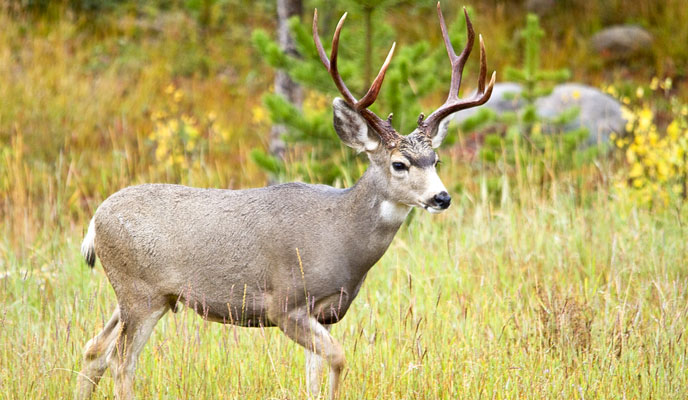This story comes through a content-sharing partnership with Wyoming Public Radio.
The Wyoming Game and Fish Commission met last week and discussed how the harsh winter is affecting wildlife. Primarily, the game is suffering, but the fish are thriving.
The main topic for wildlife was mule deer. The population in the state has declined by about 40 percent since the 90s, and one of the main threats to the herds, other than disease and predation, is winter weather.
Extreme winters
Six years ago Wyoming had an extreme winter that killed off all of the radio collared mule deer fawns and 40 percent of female does in the Wyoming Range. There is concern that mule deer herds will take another hard hit this year, given the above average snow and extremely cold temperatures.
“So this is the real deal winter, and we’re in the thick of it at the moment,” Ian Tator, Wyoming Game and Fish Department (WGFD) terrestrial habitat manager, said to the commission.
Tator pointed out that last year he was presenting to the commission that about 81 percent of the state was in extreme drought.
“And that really dominated the storyline this year, what we’re talking about is kind of the opposite,” he said.
So now we have 11 percent of the state in severe, extreme drought. And the bigger issue, obviously, is the deep, persistent snow and cold conditions that we’ve seen so far this winter.”
He said the conditions are affecting wildlife’s ability to forage for food and it is harder for them to move around, which means exerting more energy.
‘Bleak conditions’
Tator reviewed all regions in the state and how the weather has affected wildlife. He described the Sheridan and Laramie regions as a ‘mixed bag’ depending on the specific area, but the four other regions are ‘bleak.’
Tator did point out that the silver lining is all the moisture will create great habitat and forage going forward.
“Important forage for mule deer responds favorably to winter-spring moisture when we get that moisture into the soil profile,” Tator said. “It’s kind of hard to see it at this point, but that is the good news.”
During public testimony, Tedd Jenkins, a hunting guide in Star Valley, spoke about his concern for the mule deer populations.
“I’m afraid that if we keep going the way we’re going the last 10 years, in another 15 to 20 years, our deer are going to be really easy to count,” he said. “And I hope that we don’t ever get to that point.”
Jenkins suggested changes to hunting quotas or creating a mule deer management stamp for hunters, which could supply more funds to help keep mule deer alive. The commission said there will be more conversation about this topic and that concerned members of the public should attend their local season setting meetings, which start later this month.
Thriving fish
Notably, Wyoming does not have an accurate count of mule deer numbers, and the WGFD is currently working on a five-year project that will detail more up-to-date herd numbers and also study the habits of the populations.
Later in the meeting, the commission did hear from one group that is thriving from the winter conditions – fish.
“We’ve seen a lot of snow, we’re making water, fish like water, fish should do well, any questions?,” Paul Dey, WGFD aquatic manager, lightheartedly told the commission.
For the most part, the average snowpack in the state is well above average, which will likely produce strong spring runoffs. Dey said typically two to three years after high water flows, fish populations are larger. He noted that just how strong spring runoff will be is still a little unclear, as it will depend on the weather in May and June.






